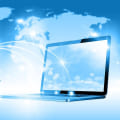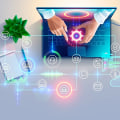A remote desktop is a feature of the program or operating system that allows the user to connect to a computer in another location, view the desktop of that computer, and interact with it as if it were local. A remote computer is a computer that a user does not have physical access to, but can access it remotely over a network link from another computer. Remote connections are made by using a network that connects the computer and the device that is used to access it. The easiest way to explain Remote Desktop is to say that it's a bit like using remote control software.
It allows users to connect to a specific computer and control it via the Internet as if they were right in front of it. If you have ever received a technical support call and the technician takes the mouse cursor to execute a correction, you are using remote desktop technology. Remote Desktop is a client application that allows a “client computer” to connect to a “host computer” from a remote location. Users can then control and use the host device's applications and files from anywhere.
That's why most, if not all, of remote control software vendors do their best to provide maximum security to their customers' computers in order to prevent any violations caused by unwanted online attacks. With remote desktop services, workers can access these remote connections from the corporate system or from the Internet. Technical support scammers use remote desktop software to connect to the victim's computer and often use Syskey on the computer if the victim doesn't cooperate. Because a computer's IP address is unique, it is used to specifically identify the computer that can be accessed remotely via a known network or the Internet.
Remote desktop software captures mouse and keyboard inputs from the local computer (client) and sends them to the remote computer (server). According to Techopedia, remote access control software is a tool that allows a local user to connect to and access a device, specifically a computer, remotely. It also refers to the function that provides mutual interaction between the local computer and the remote device. Remote desktops also have a great advantage for security development, as companies can allow geographically dispersed software engineers to operate and develop from a computer that can be stored in the company's office or in the cloud environment.
If the remote computer allows the local computer to take control of it, a notification message will appear indicating that the local computer has taken control of the remote device. Usually, remote access control software requires authentication to access first before connecting both computers to each other. As stated above, most remote access control programs will require you to obtain permission before accessing a remote computer. Since the advent of cloud computing, remote desktop software can be hosted on USB hardware devices, allowing users to connect the device to any PC connected to their network or to the Internet and recreate their desktop through a cloud connection.
Most remote access control programs come with a bunch of tools that allow you to customize the appearance of the remote desktop. It may be useful to know how remote access to computers works, what the potential security risks are, and how you can access other computers and networks remotely and securely. Here are some steps you can take to help protect your computer and data while relying on remote access. .


